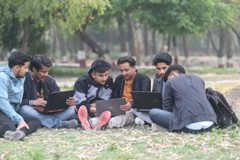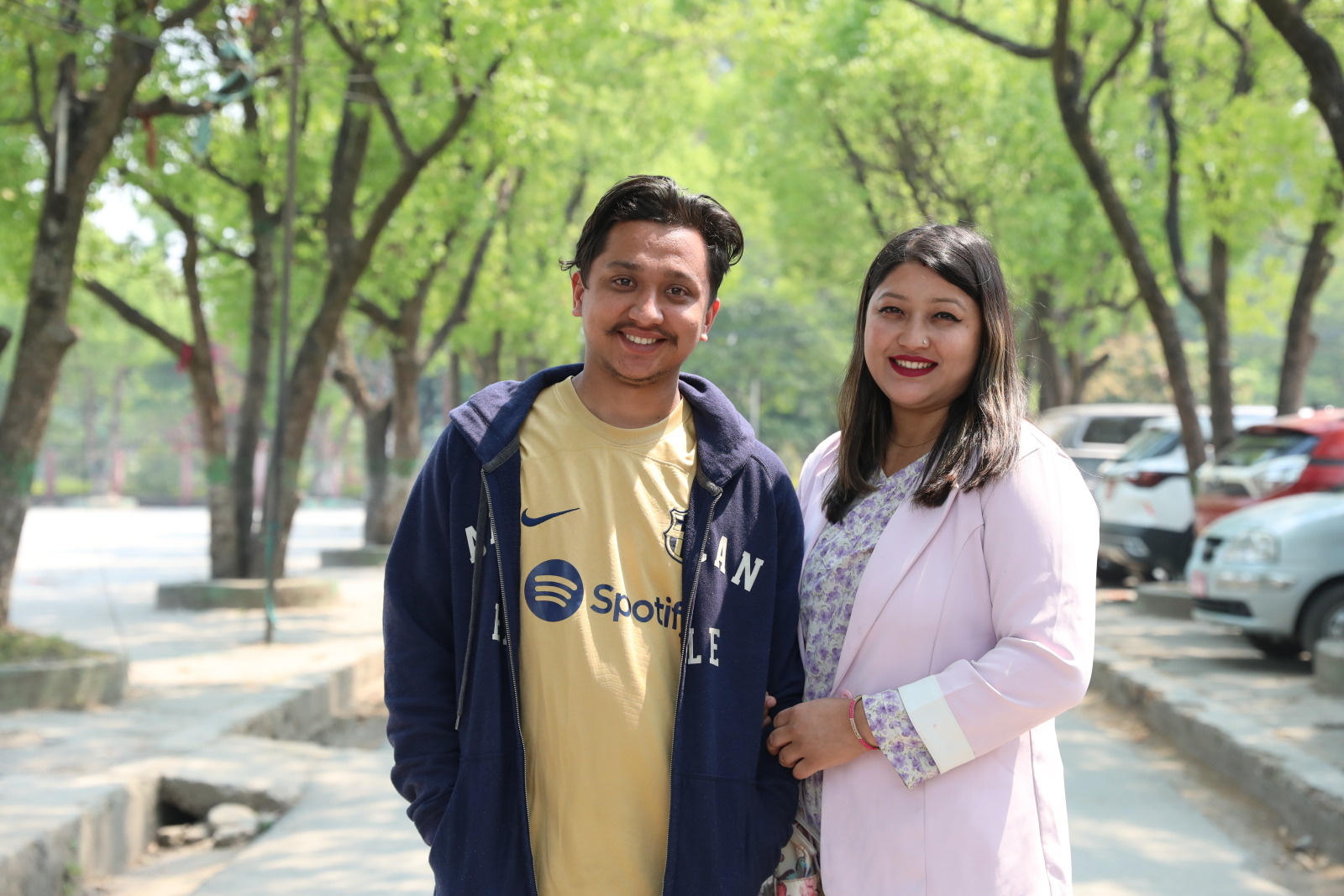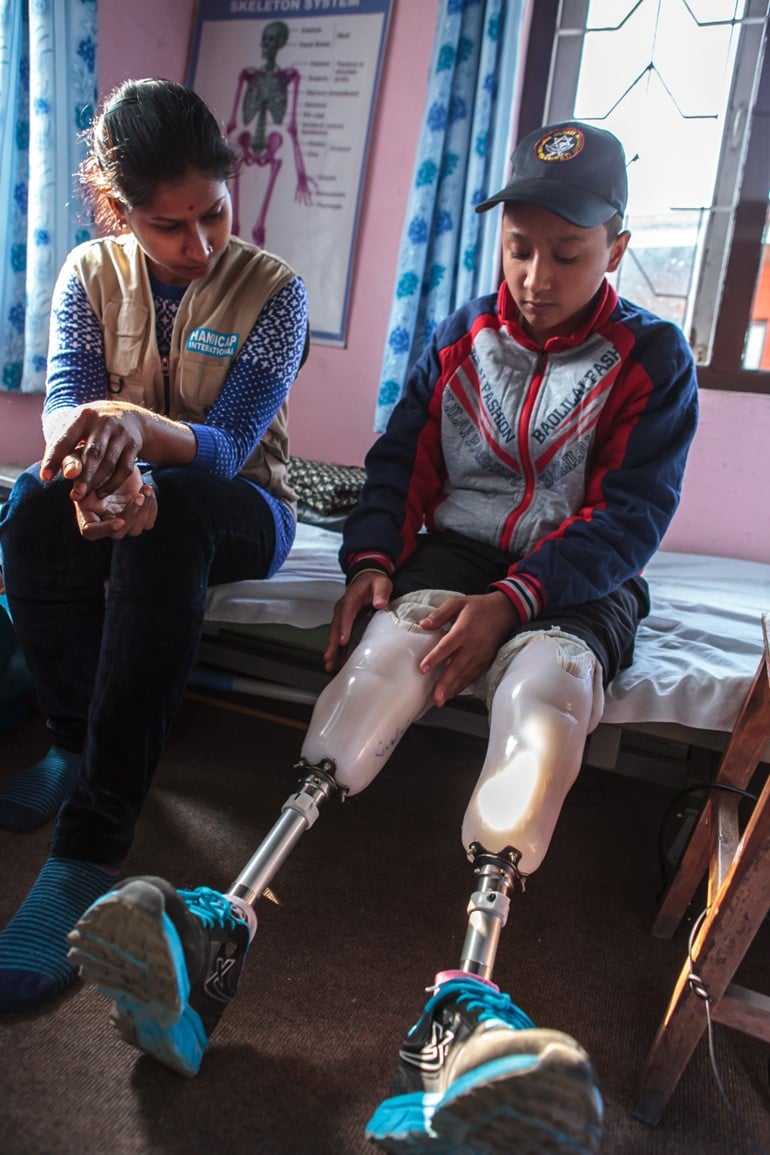2015-2023: 8 years on, what has become of Sandesh who lost both legs in the earthquake?
Sandesh was only a teenager when he lost both of his legs in the earthquake that hit Nepal in 2015. Since then, HI teams have been supporting him as he rebuilds his life.

© Amul Thapa / HI
A group of Nepalese students walk arm in arm along the paths of a park in Kathmandu. They sit down on the grass and open their computers. They are, they hope, Nepal’s future computer programming "hotshots". Among them, a young man, is smiling broadly. His name is Sandesh. He is 21 years old. His boyish cheeks have disappeared and he now sports a moustache. But his eyes sparkle with the same enthusiasm as when he tried on his very first pair of prostheses at the HI-supported rehabilitation centre in Kathmandu several years ago.
Sandesh is a survivor of the 2015 earthquake in Nepal. Eight years on, HI is still at his side.
"The boarding school wall collapsed onto my shoulders and legs"
25 April 2015. Sandesh was a teenager like any other. When he was not studying, he was playing "Ludo", his favourite board game, with his classmates. That day it was almost noon and Sandesh was on his lunch break. Suddenly, everything around him began to shake.
"My friends started screaming and I panicked too. We started to run but when we got to down to the ground floor, the wall collapsed onto my shoulders and legs."
His friends quickly moved him to safety. Eight years later, he remembers everything: arriving at the emergency room, the extreme pain, the tension of the medical staff, the voices of his friends, some of them lying injured next to him. He says he thought of his mother, who was living in a village about 40 minutes from Kathmandu at the time. Is she safe? Does she even know that I am in hospital? Fortunately, Sandesh's entire family was safe.
 He was severely injured. Both of his legs had to be amputated. After many weeks of convalescence, Sandesh arrived at the HI-supported rehabilitation centre in Kathmandu. His older sister, to whom he is very close, accompanied him to his very first rehabilitation session.
He was severely injured. Both of his legs had to be amputated. After many weeks of convalescence, Sandesh arrived at the HI-supported rehabilitation centre in Kathmandu. His older sister, to whom he is very close, accompanied him to his very first rehabilitation session.
"My sister stayed with me and supported me when I was still in a wheelchair until I was given my very first pair of prostheses. I'm so grateful to her... When I think back, I’m really moved by that," he says.
Walking again
January 2016, HI-supported rehabilitation centre in Kathmandu. Sandesh remembers that he had to be quick that day because he had a class right after the appointment with the medical teams.

"When I put the prostheses on, I felt like I could walk again for the first time since the earthquake. At first, I wasn't very sure of myself and they hurt my legs. But I kept them on and took them home with me and it got easier and easier
“The rehab centre changed my life”
April 2023. Today, when he arrives at the rehabilitation centre, Sandesh feels at home. He knows the procedure by heart. He carefully removes his old prostheses, then the protection for his stumps, and tries on his new ones. He has just received his fifth pair of prostheses.
Under the watchful eye of Ram, the prosthetist, he stands up and takes a few steps. Ram takes the time to adjust the height of his new devices, tightening and loosening the various screws so that they are as comfortable as possible. The teams at the centre have accompanied him through every stage of his rehabilitation.
“The rehab centre changed my life. Now I feel like I can do anything I want", concludes the young man.
{0>Mieux se préparer aux catastrophes pour réduire les risques<}0<0}Better disaster preparedness to reduce the risks
The violent earthquake that struck Nepal in 2015 left 8,000 people dead and over 22,000 injured. HI's teams, who have been working in Nepal since 2000, launched an emergency response to assist the victims.
Pauline Nadim Ducos is the Regional Director of the India, Nepal and Sri Lanka Programme (INNESKA):
"After the earthquake in 2015, the Nepalese government put new policies and regulations in place to ensure the safety of buildings and infrastructure in the event of future earthquakes. The disaster highlighted the urgent need for disaster preparedness and risk reduction measures and led to increased awareness and action. HI has developed a number of projects in Nepal to support people, including the most vulnerable, and help them prepare for natural disasters."
{0>Sandesh fait partie des bénéficiaires du programme « PRA » (Physical Rehabilitation Activity) mis en place depuis 2019 au Népal. Ce projet a pour but de soutenir les autorités népalaises dans le développement des services de réadaptation dans leur système de santé, renforcer l’action des professionnels de la réadaptation au Népal en renforçant la formation et les équipements de 5 centres de réadaptation.<}0{Sandesh is one of the beneficiaries of the "PRA" (Physical Rehabilitation Activity) programme supported by USAID and implemented since 2019 in Nepal. This project aims to support the Nepalese authorities in the development of rehabilitation services in their health system and to strengthen the action of rehabilitation professionals in Nepal through further training and the equipment of 5 rehabilitation centres.<0}




